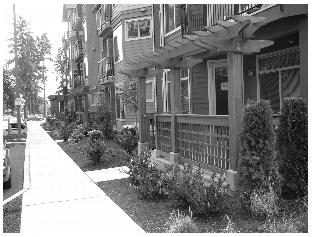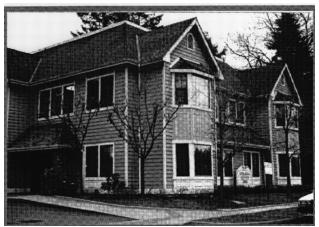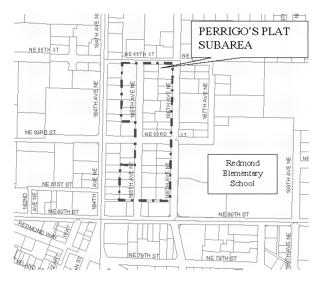20D.40.145 North Point, Carter and East Hill Districts.
20D.40.145-010 Intent.
(1) These residential districts are intended to provide a variety of housing choices. These districts are intended to provide comfortable and attractive living environments with a variety of housing types, and only limited mixed-use opportunities, in developments that include more typical residential features, such as front yards, landscaping, and ground-related patios and porches.
(2) The intent for the East Hill district is to allow Downtown’s original single-family neighborhood to evolve from its existing collection of houses into a denser multi-family neighborhood that honors the character of the original single-family houses and neighborhood character. New multi-family development, as well as conversions of the existing single-family residences to commercial uses, should maintain and enhance the residential look and character of the district.
(3) In the East Hill district, ensure that conversions of single-family residences to commercial uses are done in a manner that does not negatively affect the “residential” character of the existing structures and front yards. (Ord. 2302; Ord. 2051; Ord. 1993)
20D.40.145-020 Design Criteria.
(1) Building Orientation and Access.
(a) Buildings should be oriented toward the streets.
(b) Primary entrance of buildings shall be oriented to the street; and ground floor units that have patios along the street should be designed with walkways from the patios to the street sidewalk in order to establish a “front door” relationship with the streets. See example below. 
(c) Yards of ground floor residential units fronting on streets should be designed to provide a separation between public and private spaces, while also providing maximum territorial view of the street front from the units’ private open spaces.
(d) Vehicular access to sites from streets should be minimized. Alley access should be utilized where possible and feasible to minimize curb cuts along street fronts and to maximize the amount of available curbside parking.
(2) Building and Site Design.
(a) Buildings shall provide focus and articulation of primary entrances along the street front. Primary entrances shall not be hidden from the street or accessed via the side yard.
(b) Buildings and private usable open spaces shall be appropriately set back from property lines to provide ample light, air, and privacy for the on-site tenants and adjacent neighbors.
(c) Residential buildings should be designed to provide maximum amounts of usable open space onsite, or nearby, for the residents and to provide front yards complementary to the size and scale of the developments.
(d) Parking shall be enclosed within subterranean or semi-subterranean parking whenever possible to provide maximum amounts of usable open space on parking decks and to minimize building heights.
(e) Building facades and rooflines shall be articulated to provide visual interest and relief as well as to promote long-term neighborhood and community pride.
(f) Mixed-use buildings should be designed with a residential character, in terms of building materials, roof design, fenestration, and front yard landscaping.
(g) Open exterior corridors fronting and visible from streets and public spaces shall be minimized in use and length in order to reduce their negative visual impacts on surrounding streets and properties. They should be placed on the interior of developments whenever feasible.
(h) On-site parking, both within structures and outdoors, shall be screened from public streets. Surface parking spaces shall not be located between the building and the street.
(i) Common usable open spaces and yards shall be adequately lighted and visible from private spaces within the developments to ensure security and safety of the tenants, residents, and their guests.
(j) Conversions from single-family residences to commercial uses shall not significantly alter the residential character of the original single-family structures or front yards. Additions and/or modifications to these structures for commercial use shall maintain or enhance the residential look of the property. (Ord. 2302; Ord. 1993)
20D.40.145-030 Perrigo’s Plat Subarea.
(1) Intent. The intent of this section is to retain the quaint and inviting character of this subarea, which includes a variety of building styles and features, generous front yards, sense of quiet and peacefulness, large trees along the street, and unique bungalows, by establishing design criteria that encourage new development to emulate and enhance the traditional residential character of the subarea.
(2) Design Criteria. In the Perrigo’s Plat subarea of the East Hill district, as shown below, these additional standards shall apply.
(a) New developments, redevelopments, and remodeling projects shall emphasize features typically found in neighborhoods with older bungalow, Craftsman- and Victorian-styled homes, including but not limited to pitched roofs, dormer windows, front doors with porches or stoops oriented to the street, chimneys and double-hung or multi-paned windows.
(b) New development, redevelopment, and remodeling projects shall use high proportions of visually appealing, high-quality, exterior building materials, such as brick, stone, and masonry, on at least the base of the building. The cladding materials of the body shall also be durable, attractive, and complementary to the early 1900s Craftsman/Victorian residential style, including brick, horizontal siding, and wood (appearing) shingles.
(c) For developments consisting of multiple aggregated lots, the width of buildings fronting the street should generally be no wider than 100 feet to ensure that building mass remains consistent with the existing neighborhood character and scale. When there are buildings at the rear of the lot, behind those fronting the street, the buildings in the rear may be modulated in stories to provide a sense of building separation.
(d) New development, redevelopment, and remodeling shall be designed with front yards characteristic of single-family neighborhoods, including street trees along the street, with trees and landscaping in the front yard. (Ord. 2302)


